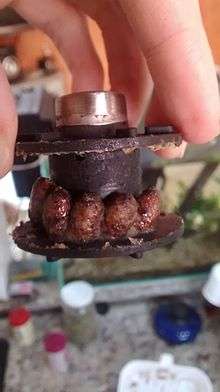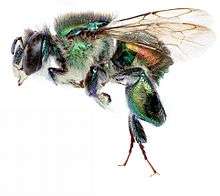Euglossa
Euglossa is a genus of orchid bees (Euglossini). Like all their close relatives, they are native to the Neotropics; an introduced population exists in Florida. They are typically bright metallic blue, green, coppery, or golden.
| Euglossa | |
|---|---|
 | |
| Male of unidentified Euglossa species | |
 | |
| Female E. hyacinthina | |
| Scientific classification | |
| Kingdom: | Animalia |
| Phylum: | Arthropoda |
| Class: | Insecta |
| Order: | Hymenoptera |
| Family: | Apidae |
| Tribe: | Euglossini |
| Genus: | Euglossa Latreille, 1802 |
| Diversity | |
| > 110 species | |
Euglossa intersecta (formerly known as E. brullei) is morphologically and chromatically atypical for the genus, and resembles the related Eufriesea in a number of characters including coloration.[1]
Distribution
Euglossa occurs naturally from Mexico to Paraguay, northern Argentina, western Brazil, Jamaica,[2] and Trinidad and Tobago, but one species (E. dilemma) has recently been introduced to Florida in the United States [3]
Species
|
|

Eggs (inside cells) laid by a solitary bee in a gardening equipment: Wax can be seen in the edges.
gollark: 65, sure.
gollark: With a correlation *this* strong, I don't think it actually can be wrong.
gollark: Ah, I see.
gollark: 103.
gollark: Let me just compute what it says the value will be today.
References
- Williams, Norris H. & Whitten, W. Mark (1983): Orchid floral fragrances and male euglossine bees: methods and advances in the last sesquidecade. Biol. Bull. 164: 355-395.
- dos Anjos-Silva, Evandson J.; Camillo, Evandro & Garófalo, Carlos A. (2006): Occurrence of Aglae caerulea Lepeletier & Serville (Hymenoptera: Apidae: Euglossini) in the Parque Nacional da Chapada dos Guimarães, Mato Grosso State, Brazil. Neotrop. Entomol. 35(6) doi:10.1590/S1519-566X2006000600024
- Skov, C.; Wiley, J. (2005). "Establishment of the Neotropical Orchid Bee Euglossa viridissima (Hymenoptera: Apidae) in Florida". Florida Entomologist. 88 (2): 225. doi:10.1653/0015-4040(2005)088[0225:EOTNOB]2.0.CO;2.
- Nemésio, André (2012): Species of the Euglossa Latreille, 1802 (Hymenoptera: Apidae: Euglossina) belonging to the purpurea species group occurring in eastern Brazil, with description of Euglossa monnei sp.n. Zootaxa 3151: 35-52.
- Nemésio, André (2011): Euglossa marianae sp. n. (Hymenoptera: Apidae): a new orchid bee from the Brazilian Atlantic Forest and the possible first documented local extinction of a forest-dependent orchid bee. Zootaxa 2892: 59-68.
Further reading
- "Euglossa". Integrated Taxonomic Information System. Retrieved 12 June 2008.
- Nemésio, A., (2007): Three new species of Euglossa Latreille (Hymenoptera: Apidae) from Brazil. Zootaxa, vol. 1547, p. 21-31
- Roubik, D. W. (1989): Ecology and natural history of tropical bees. New York: Cambridge Univ. Press.
- Cameron, Sydney A.( 2004): Phylogeny and Biology of Neotropical Orchid Bees (Euglossini). Annual Review of Entomology 49: 377-404. doi:10.1146/annurev.ento.49.072103.115855
External links
| Wikimedia Commons has media related to Euglossa. |
- David Roubik (Smithsonian Tropical Research Institute): Diagnostic photographs of several Euglossa species
- Euglossa dilemma on the UF / IFAS Featured Creatures website.
This article is issued from Wikipedia. The text is licensed under Creative Commons - Attribution - Sharealike. Additional terms may apply for the media files.
